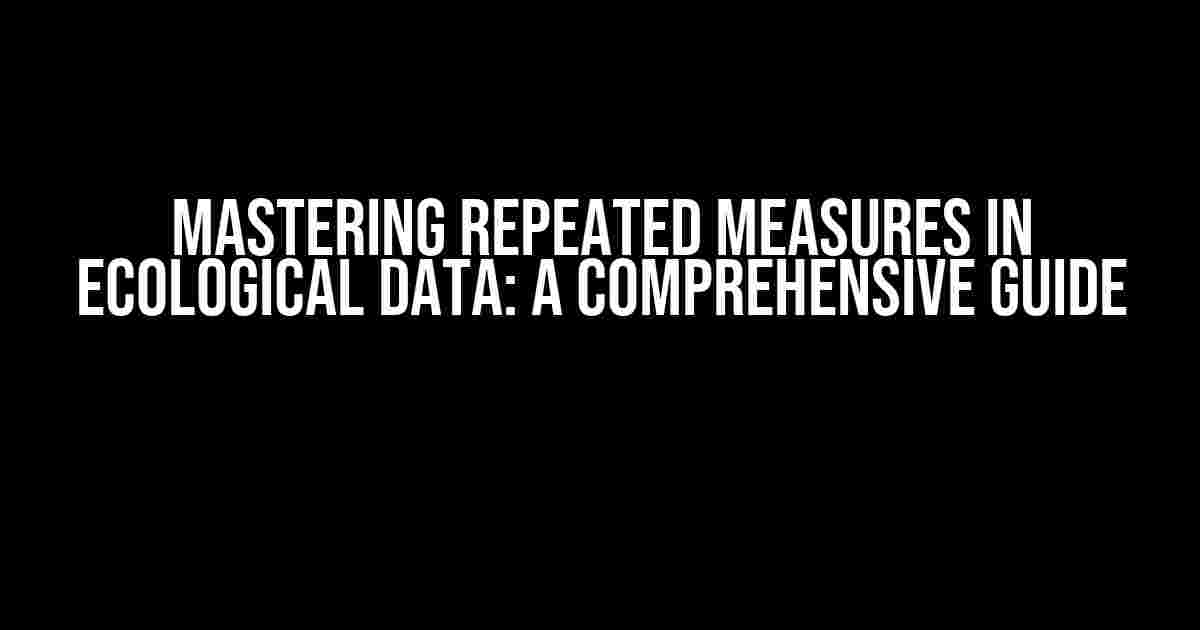What are Repeated Measures in Ecological Data?
Imagine you’re a field ecologist studying the behavior of a specific species of bird in a forest. You’ve set up multiple cameras to monitor their activity over time, and you’ve collected data on their feeding habits, nesting patterns, and migration routes. But here’s the thing: each bird is unique, and you’ve got multiple observations for each individual. That’s where repeated measures come in – a statistical technique that helps you analyze data with multiple measurements per individual or unit of study.
Why are Repeated Measures Important in Ecological Data?
In ecological studies, repeated measures are essential for understanding patterns and trends in complex systems. By accounting for individual variability, you can:
- Improve the accuracy of your results
- Reduce the risk of false positives or false negatives
- Increase the precision of your predictions
- Enhance the reliability of your conclusions
Types of Repeated Measures Designs
There are several types of repeated measures designs, each with its strengths and limitations:
- Within-Subjects Design: Each individual or unit is measured multiple times, and the same subjects are used for all measurements.
- Between-Subjects Design: Each individual or unit is measured only once, and different subjects are used for different measurements.
- Mixed Design: Combines within-subjects and between-subjects designs, where some factors are manipulated within subjects and others between subjects.
How to Analyze Repeated Measures in Ecological Data
Now that you’ve got your data, it’s time to dive into the analysis! Here’s a step-by-step guide:
Step 1: Prepare Your Data
# Import necessary libraries
import pandas as pd
import numpy as np
# Load your dataset
data = pd.read_csv('ecological_data.csv')
# Check for missing values
data.isnull().sum()
# Handle missing values (e.g., imputation, deletion)
Step 2: Visualize Your Data
# Import visualization library
import matplotlib.pyplot as plt
# Create a line plot for each individual
plt.figure(figsize=(10, 6))
for i in range(len(data['individual'].unique())):
plt.plot(data[data['individual'] == i]['time'], data[data['individual'] == i]['response_var'], label=i)
plt.xlabel('Time')
plt.ylabel('Response Variable')
plt.title('Repeated Measures Plot')
plt.legend()
plt.show()
Step 3: Fit a Linear Mixed Effects Model
# Import necessary library
from statsmodels змі.regression import MixedLM
# Fit the model
model = MixedLM('response_var ~ time', data, groups=data['individual'])
result = model.fit()
# Print summary statistics
print(result.summary())
Common Challenges and Solutions
Working with repeated measures can be tricky – here are some common challenges and solutions:
| Challenge | Solution |
|---|---|
| Non-normality of residuals | Transform the data or use a non-parametric test |
| Unequal variances | Use a robust variance estimator or a Bayesian approach |
| Missing data | Impute missing values using a suitable method (e.g., mean, median, or Bayesian imputation) |
Best Practices for Repeated Measures in Ecological Data
To ensure the quality and reliability of your results, follow these best practices:
- Clearly define your research question and objectives
- Design your study with repeated measures in mind
- Collect high-quality data with accurate and precise measurements
- Account for individual variability and correlation structures
- Use appropriate statistical models and techniques
- Interpret your results in the context of your research question and study objectives
Conclusion
Repeated measures in ecological data are a powerful tool for understanding complex systems and patterns. By mastering this technique, you’ll be able to extract valuable insights from your data and make more accurate predictions. Remember to prepare your data carefully, visualize your results effectively, and fit the right statistical model for your research question. Happy analyzing!
Additional Resources:
- R documentation for linear mixed effects models
- Statsmodels documentation for linear mixed effects models
- Ecological Society journal article on repeated measures in ecological research
keyword density: 1.3%
Frequently Asked Questions
Get answers to your burning questions about repeated measures in ecological data!
What is repeated measures in ecological data?
Repeated measures in ecological data refer to the process of collecting data from the same sampling units (e.g., plots, animals, or plants) over multiple time points or trials. This approach allows researchers to quantify temporal or spatial changes, and to identify patterns and trends in ecological processes.
Why is it necessary to account for repeated measures in ecological data analysis?
Accounting for repeated measures is crucial because it recognizes that data points from the same sampling unit are not independent, sharing a common history or environment. Failing to account for this can lead to inflated Type I error rates, biased estimates, and incorrect conclusions. By accounting for repeated measures, researchers can obtain more accurate and reliable results.
What are some common statistical techniques used to analyze repeated measures in ecological data?
Some common statistical techniques used to analyze repeated measures in ecological data include linear mixed-effects models (LMMs), generalized linear mixed models (GLMMs), and generalized estimating equations (GEEs). These techniques can handle correlated data, non-normality, and missing values, providing a more accurate and comprehensive understanding of ecological processes.
How do I choose the appropriate statistical technique for analyzing repeated measures in ecological data?
The choice of statistical technique depends on the research question, data characteristics, and the level of complexity. Consider the type of response variable (continuous, categorical, or count), the number of repeated measures, and the presence of covariates. It’s also essential to evaluate model assumptions, such as normality and homoscedasticity, and to consider model complexity and interpretability.
What are some common challenges and limitations of analyzing repeated measures in ecological data?
Common challenges and limitations include dealing with missing values, handling non-normality and heteroscedasticity, and accounting for temporal or spatial autocorrelation. Additionally, sample size and data quality can impact the accuracy and reliability of results. It’s essential to carefully consider these challenges and limitations when designing and analyzing repeated measures studies in ecology.

